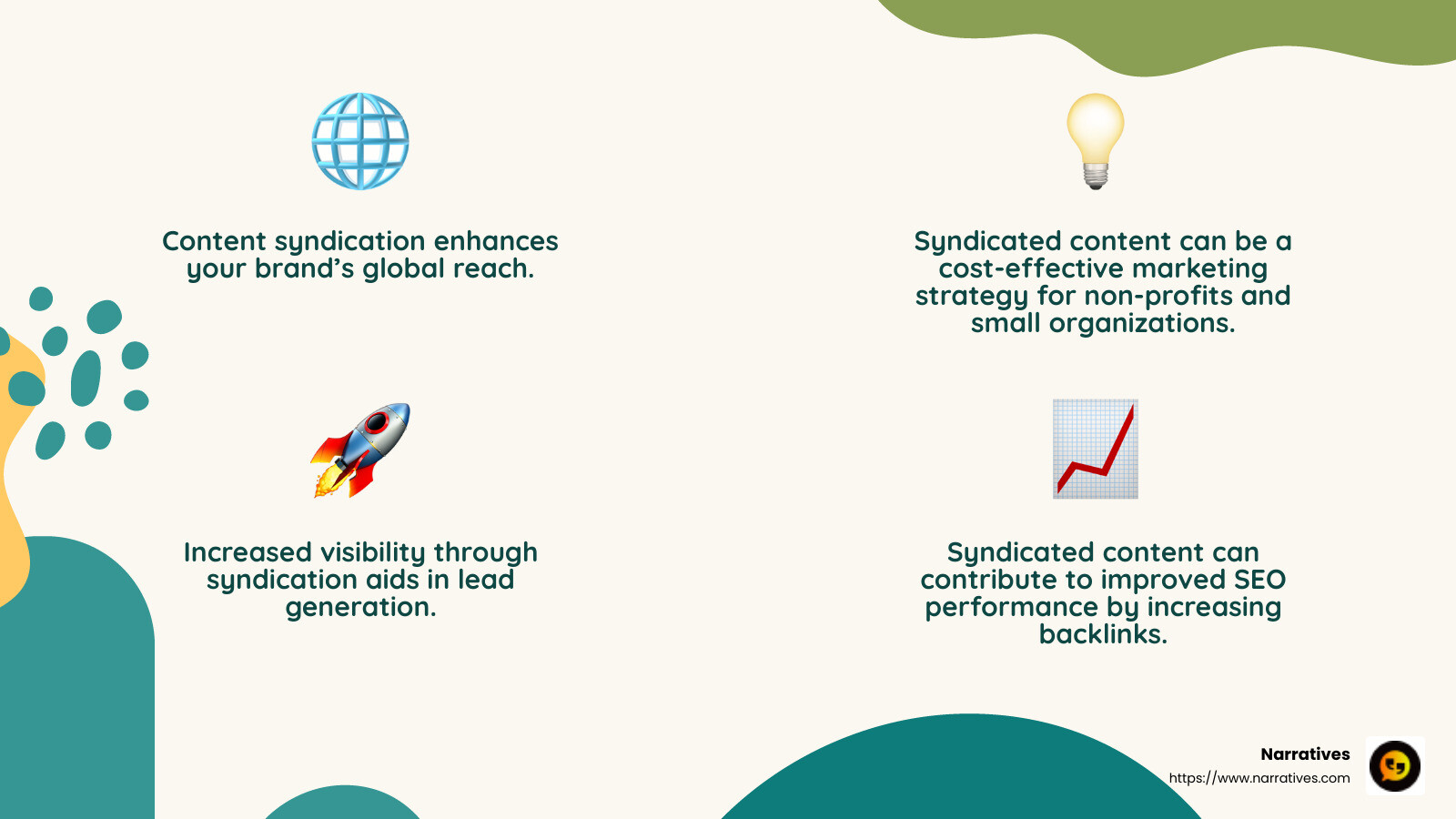Content Syndication: How It Works and Why It Matters

How does content syndication work? Let's break it down for you: Content syndication is all about sharing your work on different platforms to reach a wider audience. Imagine you wrote a great blog post. With content syndication, you can get that post shown on other websites, allowing more people to see it. Here's a quick overview:
- Create valuable content: Write articles, make videos, or create graphics that tell a powerful story.
- Partner with other sites: Find platforms or partners that will share your content with their audiences.
- Expand your reach: Your content appears on multiple sites, reaching new viewers beyond your own audience.
For non-profits and organizations that are mission-driven, content syndication is a powerful tool. It transforms digital storytelling into an outreach powerhouse. It allows you to amplify your message, engage communities, and inspire action without reinventing the wheel. Non-profits often face the challenge of limited resources but need to share their stories to drive change and secure support. Syndication helps them overcome bandwidth issues and extend their storytelling impact nationally and even globally.
By sharing your content on multiple platforms, you improve your visibility and establish a strong online presence. This not only boosts awareness for your cause but also strengthens your brand. It's about creating a ripple effect, where your story resonates and inspires beyond your initial reach.
Accept the power of syndication and let your stories be the changemakers you envision them to be.

Learn more about how does content syndication work:
What is Content Syndication?
Content syndication involves republishing your original content on third-party websites. This strategy increases your brand's visibility and helps you reach a broader audience.
Republishing Content
When you syndicate content, you're sharing the same piece—like a blog post or video—across different platforms. The idea is to maximize the impact of your content creation efforts by getting it in front of more eyes. For instance, a compelling article about your organization's mission can be republished on various sites, allowing it to resonate with different audiences.
Third-Party Websites
Third-party websites are crucial in this process. These are platforms that agree to republish your content, often because it aligns with their audience's interests. By partnering with websites that cater to your target demographic, you ensure that your content reaches the right people.
For example, if your organization focuses on environmental issues, syndicating your content on eco-friendly blogs and news sites can amplify your message. These partnerships are mutually beneficial: you gain exposure while the third-party site gets quality content to engage their readers.
Brand Visibility
Increasing brand visibility is a significant benefit of content syndication. By appearing on multiple platforms, your brand becomes more recognizable. This is especially important for non-profits and small organizations that might struggle with limited marketing budgets.
When your content is spread across various reputable sites, it builds trust and authority. Over time, this can lead to increased support and engagement from your audience. It’s like planting seeds across a wide field; the more you plant, the greater the chance of growth.
Content syndication is a strategic way to extend your reach without constantly creating new content. It allows you to focus on crafting high-quality stories that resonate, while letting syndication partners help you share those stories far and wide.
How Does Content Syndication Work?
Benefits of Content Syndication
Content syndication is an effective marketing strategy that can significantly expand your audience reach. By distributing your content across various platforms, you can achieve several key benefits:
Brand Awareness: Syndicating content increases your brand's visibility. When your content appears on multiple sites, more people become familiar with your brand. This is particularly valuable for non-profits and small organizations that may not have large marketing budgets.

Lead Generation: Content syndication is a powerful tool for generating leads. By placing content on platforms that your target audience frequents, you attract potential supporters or clients.
SEO Performance: Syndicated content can improve your SEO performance. When reputable sites link back to your original content, they create backlinks that can improve your site's search engine ranking. This makes it easier for people to find you online.
Types of Content for Syndication
Not all content is created equal when it comes to syndication. Certain types of content are particularly well-suited for this strategy:
Blog Articles: Thought-provoking blog posts are a popular choice for syndication. They provide value and insights that can engage readers on various platforms.
Infographics: These visually appealing pieces break down complex information into easy-to-digest visuals. Infographics are highly shareable and can quickly capture attention.
Videos: Engaging videos are another excellent option. They can convey your message dynamically and are more likely to be shared across social media platforms.
By choosing the right types of content, you can maximize the effectiveness of your syndication efforts. Whether it's a detailed blog post or a captivating video, ensuring high-quality content is crucial for success.
Content syndication is about leveraging existing content to reach new audiences and achieve your marketing goals. It offers a way to amplify your message, build authority, and connect with more people, all while optimizing your content creation efforts.
Best Practices for Effective Content Syndication
To make the most of content syndication, follow some best practices. These will help you avoid common pitfalls and ensure your content reaches the right audience effectively.
Canonical Tags
One of the most critical elements in content syndication is the use of canonical tags. These tags tell search engines which version of a piece of content is the original. This is crucial because it helps prevent duplicate content issues, which can negatively impact your SEO performance.
For example, if your article is syndicated on another site, a canonical tag should point back to the original article on your site. This ensures search engines recognize your version as the primary one.
<link rel="canonical" href="https://www.narratives.com/original-article/" />By implementing canonical tags, you maintain control over your content's SEO value and ensure that your site gets the credit it deserves.
Partner Selection
Choosing the right partners for content syndication is vital. You want to collaborate with websites that align with your brand and reach your target audience. Look for partners that have a strong reputation and a readership that matches your ideal demographic.
Here are some tips for selecting syndication partners:
- Relevance: Ensure the partner's audience is interested in your content.
- Quality: High-quality sites can improve your brand's credibility.
- Engagement: Choose platforms where users actively engage with content.
Finding the right partners can amplify your reach and increase the effectiveness of your syndication efforts.
Content Quality
High-quality content is the backbone of successful content syndication. Whether you're sharing blog articles, infographics, or videos, ensure your content is engaging, informative, and valuable.
Here are some key aspects of content quality to consider:
- Originality: Offer fresh insights or unique perspectives.
- Clarity: Make sure your content is easy to understand.
- Visual Appeal: Use images, videos, or infographics to improve your message.
The goal is to provide content that resonates with audiences across different platforms. High-quality content not only attracts more readers but also encourages sharing and builds trust with your audience.
By focusing on these best practices—canonical tags, partner selection, and content quality—you can optimize your content syndication strategy and achieve better results. This approach helps you maintain your brand's integrity while expanding your reach and impact.
How to Avoid Duplicate Content Issues
When engaging in content syndication, one of the primary concerns is avoiding duplicate content issues. Google doesn't penalize duplicate content outright, but it can cause your SEO efforts to suffer if not managed properly. Here, we'll explore effective SEO strategies to ensure your content remains valuable and your site maintains its search engine ranking.
Canonical Links
A crucial tool in your SEO toolkit is the canonical link. This HTML element helps search engines understand which version of your content should be considered the original. By pointing to the primary version, you can avoid confusion and ensure your site retains its SEO value.
For instance, when your article is syndicated on another platform, make sure the syndication partner includes a canonical link back to your original article.
<link rel="canonical" href="https://www.yoursite.com/original-article/" />This simple step can make a significant difference in maintaining your content's authority and visibility.
Google Guidelines
Following Google's guidelines is essential to prevent any negative impact on your site's ranking. Google allows content syndication but emphasizes the importance of signaling the original source. Ensure your syndication partners include a statement like:
"This article originally appeared on Your Website and is republished here with permission."
This not only gives credit but also helps search engines and readers recognize the content's origin.
SEO Strategies
To further protect your content's SEO value, consider the following strategies:
Selective Syndication: Choose a limited number of high-quality syndication partners. This reduces the risk of your content being outranked by the syndicated versions.
Internal Links: Include links within your syndicated content that lead back to your site. This encourages referral traffic and reinforces your site's authority.
Regular Monitoring: Use tools to track where your content is being syndicated and ensure compliance with your guidelines.
By implementing these SEO strategies, you can effectively manage your content syndication efforts and avoid the pitfalls of duplicate content. This approach not only safeguards your site's ranking but also maximizes the benefits of syndicating your content.
Frequently Asked Questions about Content Syndication
Content syndication can be a game-changer for your marketing strategy, but it's natural to have questions about how it all works. Let's tackle some of the most common queries.
What is the difference between content syndication and guest posting?
Content syndication and guest posting are often confused, but they have distinct purposes.
Content Syndication involves republishing existing content on third-party sites to reach a broader audience. It's like having your article appear in multiple newspapers, each giving credit back to the original source. The goal is to expand reach and increase visibility without creating new content.
Guest Posting, on the other hand, involves writing original content specifically for another site. It's a one-time publication, and the content is unique to that platform. This strategy is often used to build relationships and authority within a particular niche.
How can content syndication improve SEO?
Content syndication can boost your SEO in several ways when done correctly.
Backlinks: Syndicated content often includes links back to your original article, which can improve your site's authority. These backlinks are valuable for improving search engine rankings.
Increased Traffic: By reaching a larger audience, syndicated content can drive more visitors to your site. More traffic can signal to search engines that your content is valuable and relevant.
Brand Visibility: As your content appears on reputable sites, your brand gains visibility and trustworthiness, which can indirectly boost SEO.
What are the risks of content syndication?
While content syndication offers many benefits, there are some risks to be aware of:
Duplicate Content: If not managed correctly, syndicated content can be mistaken for duplicate content by search engines. This can dilute your SEO efforts. Using canonical tags is essential to mitigate this risk.
Outranking: There's a possibility that syndicated versions of your content might outrank the original in search results. To avoid this, choose syndication partners wisely and limit the number of sites that republish your content.
Loss of Control: Once your content is syndicated, you have less control over how it's presented or modified. Establish clear guidelines with your partners to maintain content integrity.
By understanding these risks and implementing best practices, you can harness the power of content syndication while safeguarding your site's SEO and reputation.
Conclusion
Narratives is more than just a content agency; we are storytellers on a mission. By partnering with non-profits and purpose-driven organizations, we amplify underrepresented voices and spark meaningful change. Our work is about more than just content; it's about creating social impact through storytelling.
Content syndication plays a pivotal role in our strategy. It helps us distribute powerful stories to a wider audience, ensuring that the voices of those we serve are heard far and wide. Through syndication, we can lift narratives that inspire action, build trust, and increase visibility for the causes that matter most.
Storytelling is at the heart of what we do. It's not just about sharing facts; it's about connecting on a human level and driving social change. By leveraging content syndication, we ensure that these stories reach the right audience, sparking conversations and encouraging community involvement.
The social impact of our work is profound. By sharing stories of resilience, struggle, and triumph, we help non-profits connect with supporters and inspire them to take action. Whether it's through video, articles, or infographics, our content is designed to move hearts and minds.
If you're ready to explore the possibilities of content syndication and digital storytelling for your organization, learn more about how Narratives can help. Together, we can create content that not only informs but transforms.


